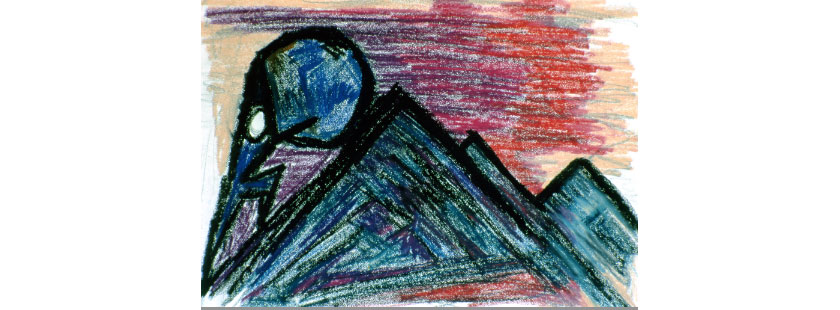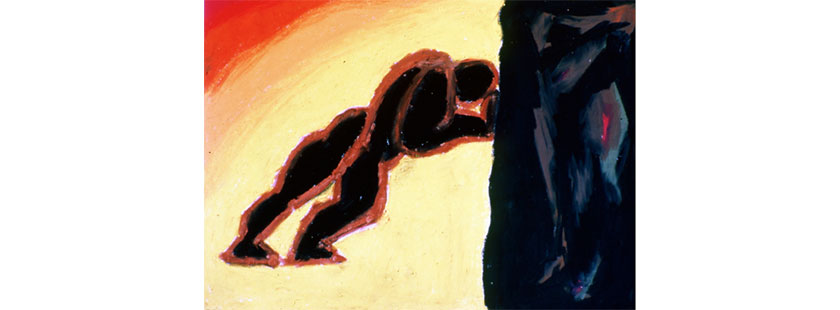A chronicle of "the hero's journey" in pictures.
In the "Call of the Wild" chapter of Vital Signs, I include several drawings I did as part of a two-year attempt to capture in oil-pastel drawings my passage through a particular calling–moving from the city to the country for the first time in my life. From San Francisco to a hamlet north of Taos, New Mexico called Arroyo Seco.
In doing the drawing journal, I was following the advice of Jungian psychologist James Hillman: "When you ask, 'Where is my soul? How do I meet it? What does it want now?' the answer is, 'Turn to your images'" (such as dreams and art.) And a bit of advice from the philosopher Goethe: "We talk too much. We should talk less and draw more."
As graphic and illuminating as the drawings were to me, they were matched in revelatory power by a discovery I made shortly after I finished them: Joseph Campbell's work. He's the mythologist who popularized the "hero's journey." After reading his description of its classic stages----the call, the refusal of the call, the road of trials, the allies, the obstacles, the supreme ordeal, the receiving of the gift, and the return to the community bearing the gift----I went back to my drawings and was stunned by how closely my personal journey matched, even chronologically, the age-old hero's journey. It not only gave the notion of archetypes---those ancient and universally recurring patterns in the human experience---a huge boost in credibility in my mind, but helped me learn to trust my soul even more.
Here's the rest of the story-in-pictures. The drawings that didn't make it into the book, along with explanatory captions.
-
Campbell refers to the "Ordinary World" as the everyday life of the hero when the calling comes. For me, this was dominated by work and workaholism, depicted in this first drawing as a portrait of Sisyphus, patron saint of endless effort.
-
The next step in the journey is "The Call" itself---the need for a change in the Ordinary World. This came in the form of my (ex)wife telling me she wanted to move to the country, and like a good New Yorker I said, "What country?" I pictured that call as a step into the unknown, through a threshold modeled on a wedding ring.
-
Phase One of responding to calls is typically avoiding them. Campbell calls this the "Refusal of the Call." This and the next many drawings capture various of my reactions to the call to quit city life. Here, I'm so busy freaking out that I miss all the energy and creativity right under my nose, not realizing that the degree of resistance I had would be proportionate to the amount of power and passion waiting to be unleashed.
-
One of my standard reactions to fear---a pit in my stomach.
-
Anger at having my Ordinary World rocked.
-
More of same. With this drawing, though, it began to dawn on me that there was more going on here---and more at stake---than just moving from the city to the country and losing home, friends, work, a couple of teaching positions, and familiar surroundings. There were also deep issues of security, isolation, and commitment. This was a relationship call as much as a call for a change of scenery and depth (distance from the 'distractions' of city life).
-
A depiction of casting the first stone. That is, wanting to blame someone (conveniently, my wife) for rocking the boat.
-
The Furies, the Harpies, the Gorgons. The monsters within that told me to fight The Call. (Years after I finished the drawings, I began sharing them with people at retreats, and it was this drawing that prompted my wife to say, "You're not going to show these pictures to people before bedtime, are you?")
-
Your basic manly impotent rage and frustration. Feeling out of control.
-
Among the Obstacles that arose were some original-wound, family-of-origin issues around my relationship to relationship. Part of what came up for me---not coincidentally---was the need to create some healthier boundaries with my mother, which was at the core of my struggle to create healthier relationships, balance security (my mother's mantra) with passion, and take charge of my own life.
-
In doing the journal, I sometimes discovered little unconscious commentaries hidden in the drawings. Here, there appears to be a female torso encased in that block of Obstacle.
-
In addition to Obstacles, the hero's journey also features Allies. Such as insight. Here, our hero has a bit of a breakthrough---the realization of what I'm really pushing against.
-
One of the primary Obstacles I encountered was my fear around money (and with this particular Call, the potential loss of it). When I sat down to draw this fear out, what emerged was a portrait of my parents' divorce when I was nine. The original breach in security. It was also another drawing with unconscious intelligence: the position of my parents' hands. I was only after theatrical effect---my father's hand on his heart, my mother's on her head---but I later remembered that my father suffered from heart attacks, and my mother from migraines. And the position of their other hands is intriguingly ambiguous.
-
Given the last drawing, it's no surprise that as an adult I might feel like this---torn in two. Or rather, tearing myself in two. Pulling myself in two different directions: head vs heart, passion vs security, yes vs no, us vs them. I've heard it said that heroism can be redefined for the modern age as the ability to tolerate paradox---to hold two seemingly contrary energies/ideas/impulses/beliefs inside you at the same time and still retain the ability to function---and it's apparent from this drawing that I have much to learn about holding paradox.
-
Not surprisingly, touching my original wounds triggered some grief. And griefwork is eminently in order when confronting some of what gets triggered---and must be relinquished---in order to say yes to the calls in our lives.
-
I sat down to capture the theme of "Me and my Shadow," but I'm not sure which of these two figures is which. I do remember intending to make the beast look threatening, but it clearly didn't turn out that way. A complex rendering of grief and powerlessness.
-
The portrait of another of the Allies that emerged on my hero's journey---the spirit of playfulness. It was around this time that, in a moment of desperation to undo the spell of seriousness I had cast over this whole affair, I suggested to my wife that we switch roles---that I (for a change) take the voice of yes, and she the voice of no. It was uncomfortable for both of us, but ultimately liberating, and a great lesson in the value of suffering creatively and not just neurotically.
-
Another Ally for me was a ritual I conducted around the theme of surrender and sacrifice. I took a copy of my first book---the object of much of my workaholism when the Call had first come---using it as a symbol of everything I was desperately attached to, wrote my obituary on the title page, then ripped it to shreds with my bare hands and burned it in the fireplace. It was an act which prompted my mother to declare that I was weird, but was also tremendously liberating.
-
After all my resistance to the Call---which in this case took nearly two years---I finally said Yes and made my necessary leap of faith. Looking upward this time rather than downward into the abyss, and clearly past the point of no return, what struck me about this drawing was that it took two sheets of paper to encompass, whereas all the preceding drawings took only one. The size of my world literally doubled by saying Yes.
-
In saying Yes to the Call, I leapt, in a sense, over my past, my conditioning, who I thought I was and what I thought I was capable of---as depicted by a chronological collage of pictures taken from my photo albums.
-
After the hero says Yes to the Call, he/she sets out on what Campbell calls "The Road of Trials"---contrary to what people often assume happens when they finally say Yes: that they'll be rewarded with the Midas touch and all their obstacles miraculously swept away. Eventually The Road of Trials leads to the "Supreme Ordeal" in which the hero comes face to face with his/her greatest fears. Luke Skywalker inside the Death Star; Dorothy inside the castle of the Wicked Witch.
-
This drawing was done for me by a friend, who beautifully captured the archetypal drama going on in my life at that point---a combination of trial by fire and dark night of the soul. The drawing depicts the redemption of Jonah, shown here in the maw of the whale carrying him back/forward to his Calling. Tilt your head to the left and you can make out the whale's jaw and the stars over the sea.
-
Another depiction of the trial by fire. My feeling of feeling overwhelmed by the new place to which the whale had carried me---my new home in New Mexico.
-
A portrait of discombobulation.
-
Precisely nine months after I arrived in New Mexico---in the spring after the worst winter they'd had in a decade---I began to emerge from my dark night. From the crisis of moving to the desert and facing myself without distractions, which in hindsight I realized was much of what the Calling had been about; hearing what Walt Whitman called "the song of myself."
-
Out of the Supreme Ordeal, and the hero's willingness to follow the Call, comes a phase of the journey that Campbell calls "Receiving the Gift." In my case, I began having recurring dreams of a cupbearer---a man kneeling on the ground, hoisting a large empty urn on his shoulders, and waiting. For what I didn't know. I just had a sense that I was preparing for something. Or perhaps being prepared. This is the picture I drew of my dream figure.
-
And now came The Gift---a flood of writing that eventually became the Callings book. (Once again, it took two pieces of paper to capture this image. Once again, my world expanding.).
-
Along with The Gift came a tremendous burst of energy, enthusiasm and creativity. And a restoring of equilibrium in my life (no small thing for a Libra).
-
Campbell speaks of a stage of the hero's journey he calls the Return to the Community Bearing the Gift, and toward the end of the writing of Callings I had a dream in which my wife and I were dancing and carrying a basket filled with jewels. Shortly afterward, we began teaching callings retreats at a place called Ghost Ranch in New Mexico---synchronistically the place Georgia O'Keeffe moved to from New York City in the 1920's, following a call similar to my own. And these retreats both grew out of and fed the Callings book.
-
The final stage of the hero's journey is something Campbell calls "The Final Exam," a kind of test to see if the hero has learned the lessons of the road, and a chance for the proverbial forces of darkness to take a last swing at him. It often involves challenges from the Ordinary World the hero returns to---the urgings of the status quo, the disapproval of others, the siren-song of old roles and identities, the temptation to backslide. This drawing is also a depiction of "Me and my Shadow," but during my dark nights of the soul I seriously made his acquaintance and he turned from an Obstacle to an Ally. From a demon back to a daimon, a divine guardian spirit that in Latin means soul. Interestingly, the ancient root of the word for happiness is "eudaimonia," which means a well-pleased daimon.
-
This is a strand of my daimon's DNA, and some pictorial evidence that during my hero's journey I learned a thing or two about holding paradox; the previously warring factions within me now woven together, integrated in a whole new way. The final three drawings (collages, actually) are close-ups of this newly integrated self, from top to bottom.
-
-
-


































